Webinar Review: GCs Learn How to Reduce time to Construction | Qnect
This special GC-focused webinar took place on November 20th, 2019. The webinar focuses on reducing time to construction for the general contractors....
11 min read
Pearl Burgoff
:
Mar 4, 2020 2:52:55 PM
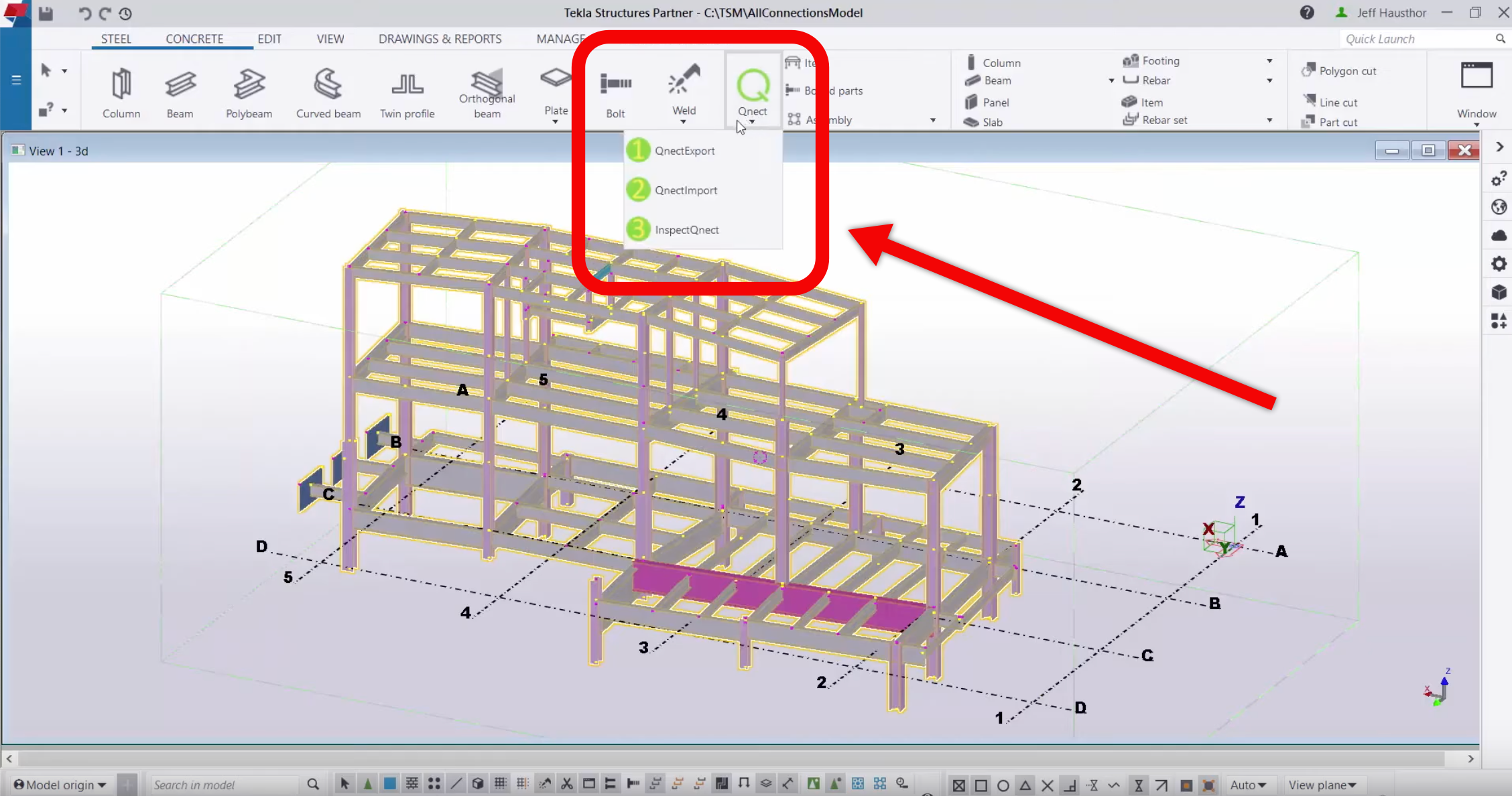
During this 30 minute webinar, we presented the benefits of delivering a connected model. This includes:
Read below for the full transcript or watch the video...or both!
Thank you for attending the Qnect webinar on the benefits of delivering a fully connected model. My name is David Kowalski, an Account Manager with Qnect. With me today is Henry Lederman, one of the founding owners of Qnect. Henry will be explaining today how Qnect is able to help with the delivery of a fully connected model. Before I get started I would like to give an overview with the material we will be covering today. Our agenda for today or will be covering who we are and what we do; the benefits of delivering a fully connected model; a demo of Qnect in action followed by a question and answer section at the end.
So who is Qnect or questions a who we are is a community we were founded in 2014 by Jef Sharp, Henry Lederman and Jeff Hausthor. Qnect is headquartered in Hadley, Massachusetts and the Qnect team has over 80 years of experience in the steel industry.
So what we do is we're able to integrate connection engineering and detailing extremely fast while lowering cost.
Thank you David and very excited to be here with everybody and excited to show you some of this not so new delivery system because there are a lot of engineer records who are doing it but to bring it to you in its fullest sense. To appreciate the opportunity of delivering a fully connected model requires visiting how it's currently done and so let's do that.
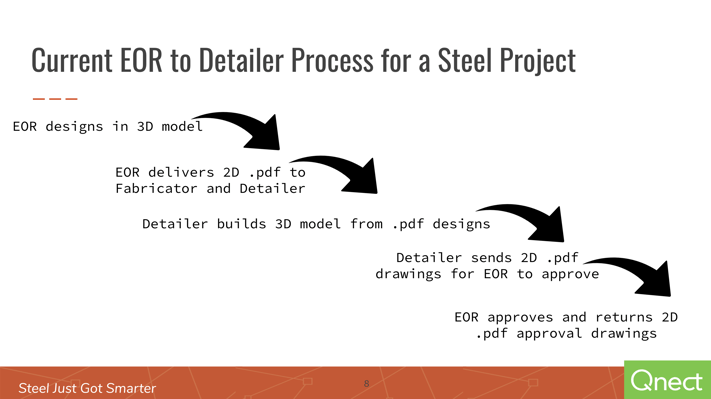
First the engineer of record (EOR) designs in a 3D model. Then, they create 2D drawings and deliver it to the fabricator and detailer. Then the detailer builds a 3D model from the PDF designs. At this point, once the detailer has prepared their shop drawings, now they send 2D drawings to the EOR to approve. An EOR approves and returns to 2D PDF approval drawings.
As you can see there's a lot of back-and-forth from 3D to a 2D and a lot of back-and-forth between these different parties. In a connected model, however, a lot of things change and change for the better.
First, the EOR designs in a 3D model. The EOR converts his Revit or IFC file into a 3D Tekla model. The EOR using Qnect, along with internal or external Connection Engineers, connects the model in Tekla. The EOR reviews all the connections and approves the model and the EOR delivers a fully connected model to the fabricator or to the GC for bidding.
As you can see already, this flows better. It's a better use of 3D technology. And we'll discuss a little further the benefits of that side of delivery. So in terms of the workflow, as we already said,
EOR converts the Revit or IFC to Tekla. EOR connects back in the model 60% to 80% of the connections using the Qnect application to date. Generally, that's what Qnect is able to do having a tremendous impact on delivery both in time and cost and we'll show you more about that shortly. Then, for the remaining connections, the EOR engineers for their remaining joints, either with their own internal staff or using Qnect partners, the EOR models the joints not done in Qnect.
Because Qnect actually models the joint, and they can do so at internal staff or using Qnect detailing partners. Then the EOR we've used all the joints and approves the Tekla model and then delivers the fully connected model to the GC to provide to the fabricators. All of those connections would already be approved. Wow, that would be something!
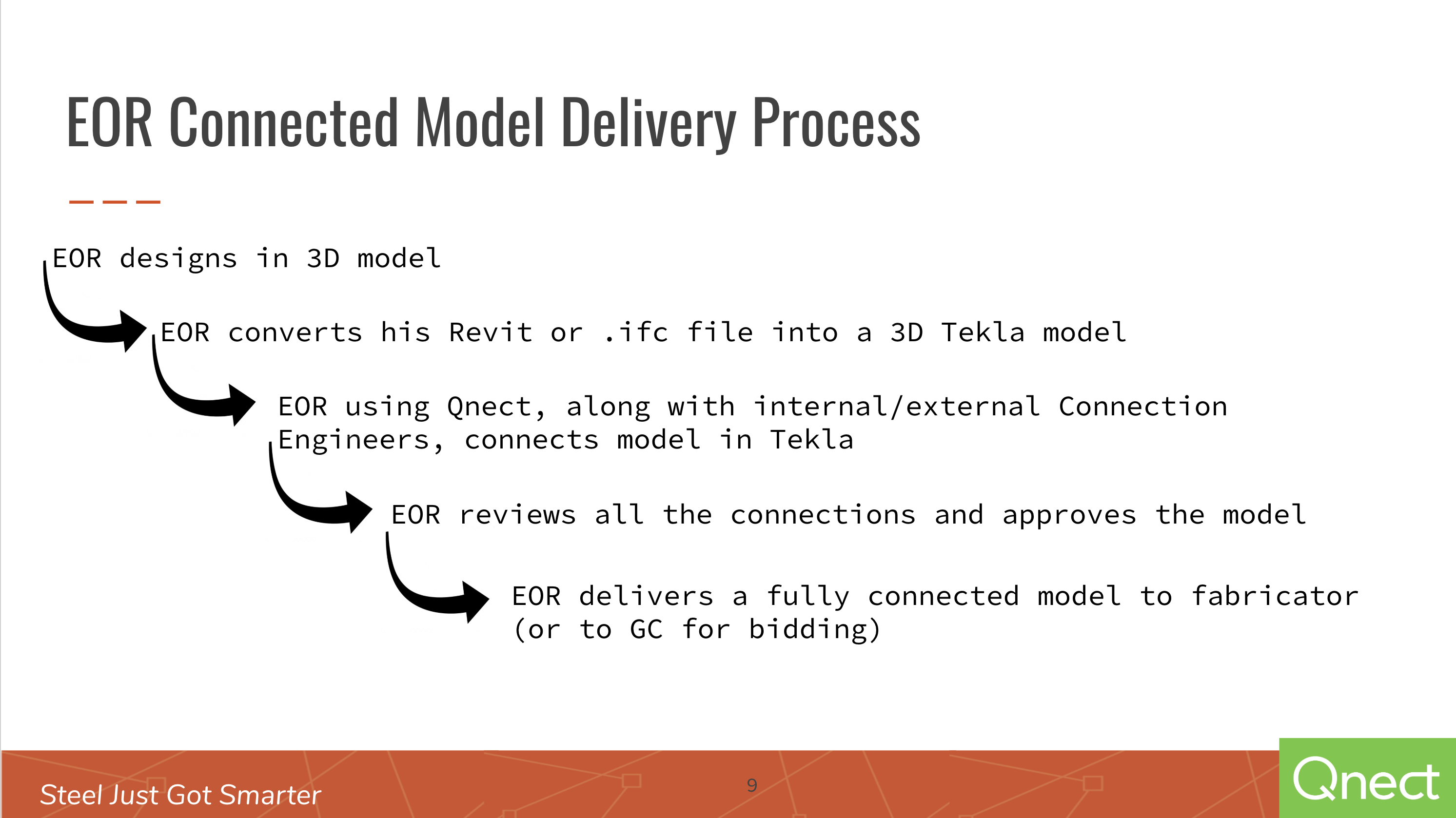
Here is a quote of a senior VP at AECOM/Tishman in New York, Allan Paull, who really has found that this kind of delivery provides a significant impact to their projects and works very hard to have every one of their projects delivered this way. As it says:
“When we convinced the owner to allow us to prepare a connected model prior to bid we have seen three to four months” improvements on the projects.
Convincing the owner is getting easier and easier and we'll discuss some what all of the ways it's happening currently. In fact I'll just give you a picture which is that this kind of delivery is dominant in New York City; it is being the speed of it is picking up where we have some national firms delivering connected model throughout the United States; and more and more EORs are picking up the mantle of this kind of delivery for the all the benefits we've discussed including and in particular to the GC and the owner time improvements. So Qnect is the infrastructure software to get this done.
What I want to do now is to show you how that happens.
So let's first go to our website. So right now you're on the Qnect website. What we setup here is a job - it should be your job - and we basically set up all the preferences that are the basis for the design of the connections. We will come back here in a few minutes but I just want you to know that up on the cloud and we're right now on our website on a cloud and using our cloud service all of these parameters have been defined and they take about 40 minutes to fill out.
You can use this process during design development to learn more about the end connections and what needs to change to help you provide a better project all the way through the final delivery. You can use Qnect multiple times on a project and because it's so extraordinarily fast you can get your results in your analytics quite quickly.
So here we are in a Tekla model. This is a stick model. This could have been converted from a Revit or IFC or drawn from scratch but in terms of a delivery and we're talking about then it would have likely have been converted from a Revit or IFC. Once you download the Qnect app you'll see the connect buttons: one, two and three.
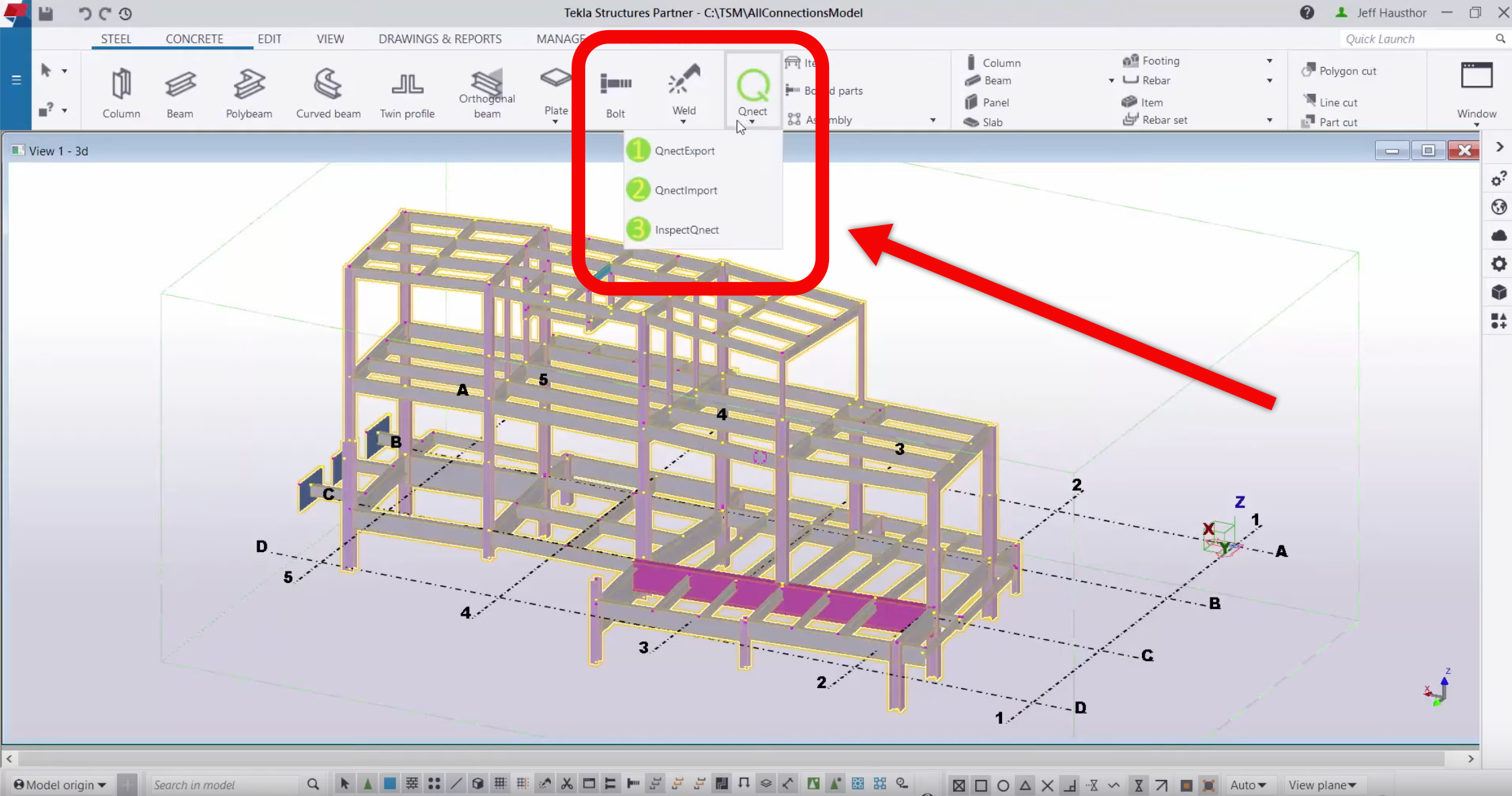
Now let's show you how this is done whether you are connecting or connecting which means engineering and detailing back into the model one joint, one division, one floor, the whole building the process is still the same:
What Qnect is doing now is grabbing all of the data from the model and bringing it up to its web servers. It's grabbing profiles, geometry, any loading, and up it goes at our website where it will be sorted: beam-to-beam, column flange, column web, fully engineered and then return back into the model fully detailed as well.
So while it's running currently, you'll see we'll take a look at some of these preferences to give you some insight - a little more insight into how this works.
As you can see the connection types here's where we select the connection type, first preference, second preference, third and fourth.
If the first doesn't work we'll go to the second if one has been chosen. As you can see, we can do share plates, extended share plates, double angles, welded bolted bolted, bolted single angles which covers most of the projects in the United States. We can also do shared, shared axil, the New York City integrity code, the IBC code...
So a lot is covered here.
Now, let's go to the forces. As you can see it says the job is running currently which this project won't take very long, Forces are done in one of several ways.
First if the loads are in your Revit model you can transfer them to the Tekla which is possible then there in the model they can be placed in the model manually from information that the EOR provides. We can also do UDL. In this case we're running UDL fact of 0.5 with some short span loading so we don't penalize the connections on short spans. We can also provide a table. Some engineers provide a table of loading and those can be just provided on our website.
So that's the forces, connection types and then we'll do some just general shop minimums maximums. Just take a look at a few more while our job continues to process. Design basis, RFD ASD. Forces as we said, axial loads as a percentage of the shear force, for some engineering firms moment connections can be activated. We do full penn moment top and bottom moment plates.
Our first bracing is coming out very shortly which will be HSS field welded to the gusset. It’s an extraordinarily efficient vertical bracing design that we have developed where we're optimizing the connection to the column to connect the gusset to the beam, the brace itself to the gusset the gusset. It's really quite extraordinary.
In the integrity checks, New York City, International IBC code, material grades, spandrel conditions, OSHA conditions, stabilizer information, minimum maximum material - all of this which we will help you fill out. Obviously as the EOR you cover your interest and requirements and we certainly can support the fabrication side of interest.
Again the job is continues to run cope clearances, radius is for cutting, distance of the first hold down, minimum setbacks, horizontal distance to the first hole, welding information and this general angle preferred angle sizes, gauges. Again all items that we will support. Once this has been filled out it can be copied to other projects.
So now we see that the the job is completed. Let's now show you the result of that. But before we do that I'm just going to activate our optimization so we can run a joint so you can see what happens. Alright, so let's go back into the model we now hit button 2 to import back in.
We find a job session we sent up and we submit now. Qnect is bringing back down all of these joints fully detailed, fully engineered. Bolts, welds back in the model basically a hundred percent complete and fully done.
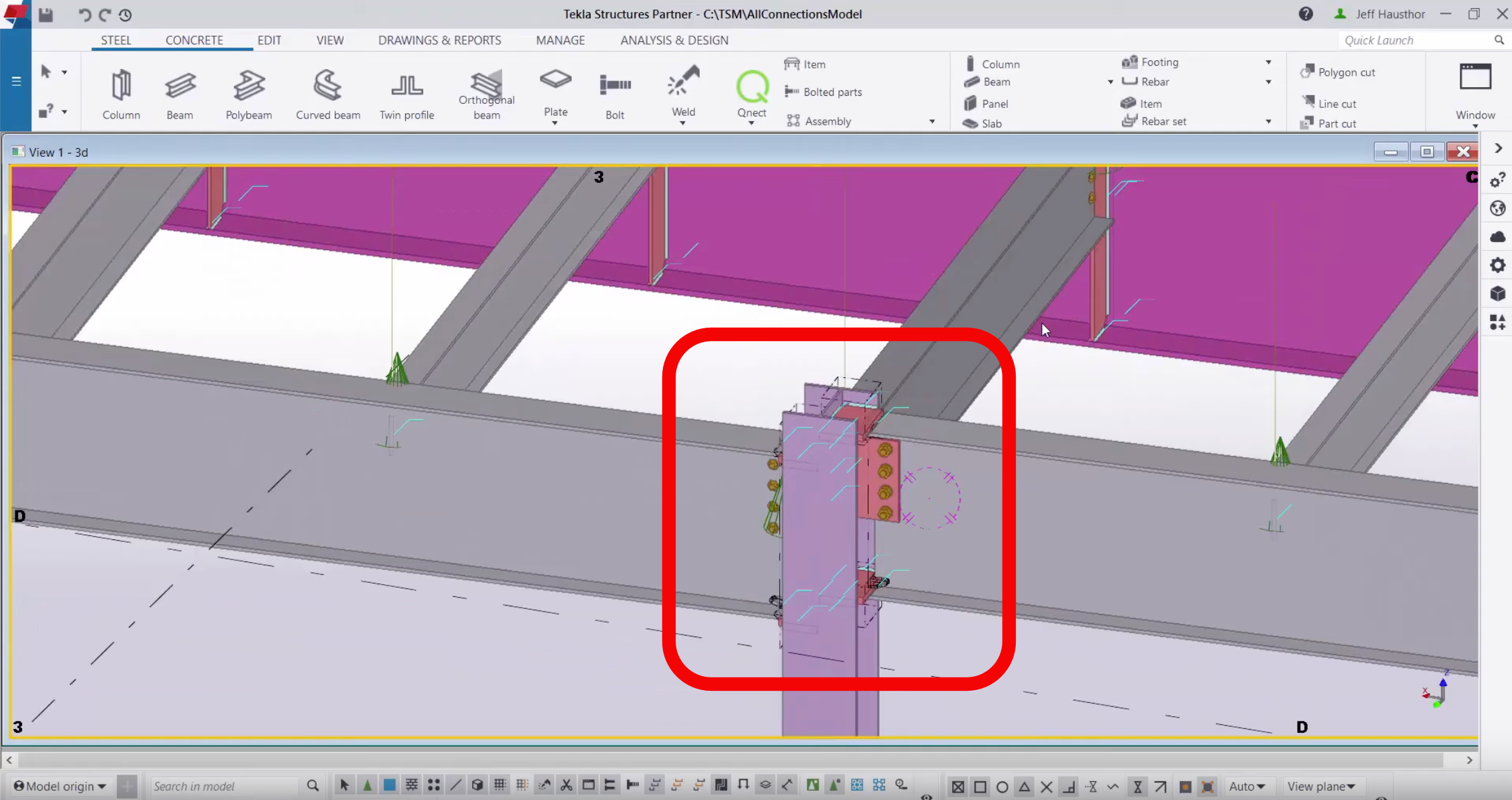
Alright, so it's bringing it back in. It's almost complete. Now we we can zoom in and observe that for example here you can see a moment connection with the rat-holes etc. We have full depth stiffeners, full depth share plates, doubler share plate here, extended share plate without stabilizers. We can even will show you basically beam to embed. In this particular you can see the plate washer. This is a hundred percent engineered all limit states and it's complete.
If we click on this cone that we see here we get the following information: we get the general output, the bolt size, the plate thicknesses etc. I'll go right to this code and if we click on a code you'll see the full engineering - all of the limit states. So this is again part of the infrastructure to help you approve the joints as you deliver an approved project.
So a project, this particular project, we connected at eighty percent in about a minute and a half. As context we connect in a forty three hundred ton project about 60% or 65% in 35 minutes and we've connected several sixty story buildings in New York City that we’re being used on in about two and a half hours fifteen thousand joints. So there is no project regardless of size that doesn't get engineered and connected in the first day - usually within hours. And so this is the first part of how we save tremendous amount of time Paul Allen was referring to about time savings.
Let's show you the second element and then we'll bring this to a close with the question and answer session.
The second element of opportunity for the client is optimizing the joint. So here we have a share plate that has six bolts. We’ll leave the loads the way it is. We’ll delete the connection you saw that before we came here; I activated the optimization setting. So again we select the joint, we hit button one, we come in, we put a session name - - and we submit. We certainly don't have to wait as long because we understand already that this takes seconds to do. But let's see if it's ready. It may or may not - it all depends on the internet speed connection.
We're going to see what happens when we optimize this particular joint. We see that it's ready and we bring it back down. So here we have a connection that previously had 6 bolts and by changing the vertical spacing we're able to save two of those six - a third of the bolts as two less bolts to purchase and four less holes to drill in the shop.
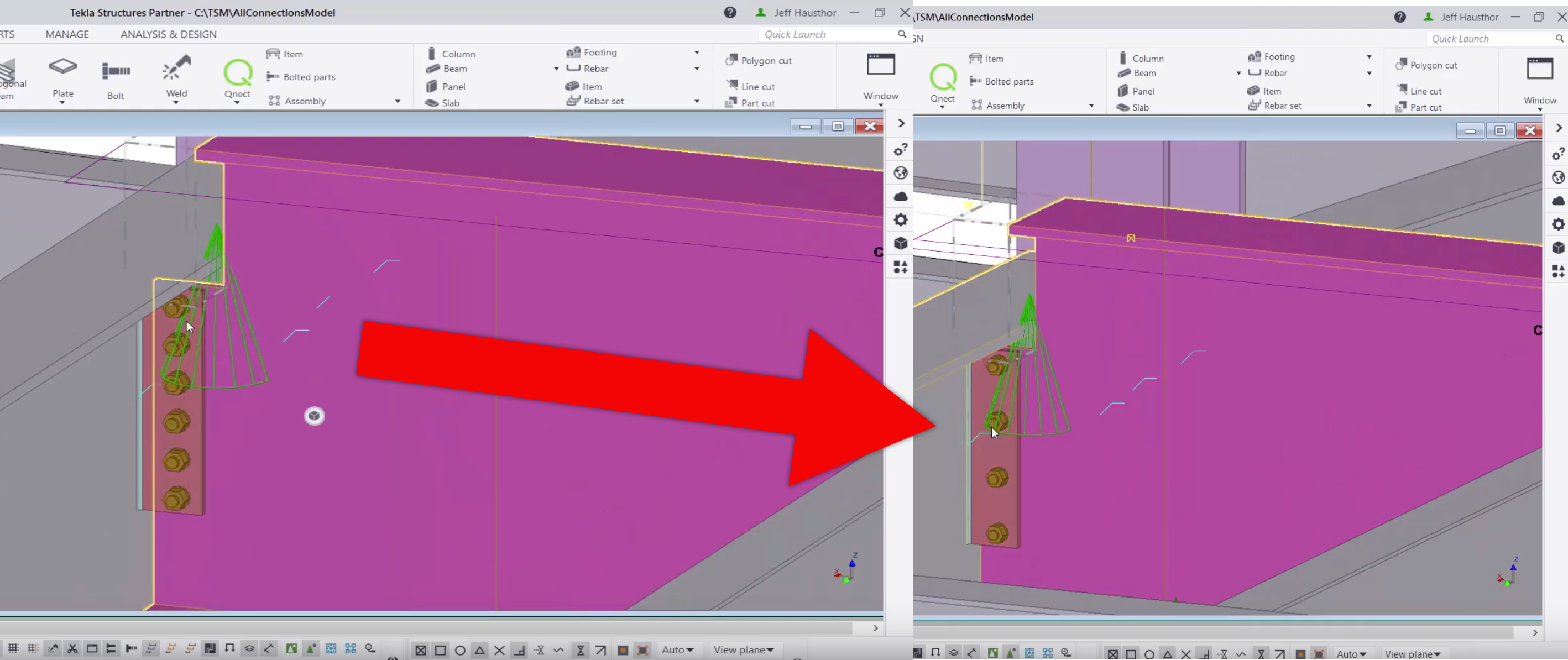
To give you a more complete picture using our optimization tools we traditionally now see the savings of one to one-and-a-half bolts per ton. That means two to three holes per ton that need not be drilled in the shop - this is a tremendous time saver for fabrication and erection especially when you think of the cost of installing a bolt.
With that let me turn this over to David - we of course can show you a lot more so depending on your interest please reach out to us and we will be able to give you some personalized attention to further pursue this kind of delivery I think you would find it very interesting as we continue.
Let me turn it over to David.We’ll see what questions coming in and please for you to send your questions in right now we'll wait a few seconds before they get in.
Thank you Henry we actually received a few great questions.
The first one would be: we don't have any in-house detailing or connection engineering how can we do this?
Any one of you any EOR currently can deliver this connected model tomorrow. How would you do that? Well Qnect would supply the detailing partner or the connection engineering partner to support you in that kind of delivery. So you can decide to take as much in-house as you'd like or to use some of our partners to deliver your project and certainly you can use our partners in a transition as you decide to develop any internal support for this delivery thank you.
The second question reads: how do we get our clients to pay for this?
Well, that's another story, you know. Here's the thing this kind of delivery saves tremendous amount of time - you've seen the quote - it saves money, it actually also has been reported it reduces extras in one case from 30% at 10% because so many things are worked out before the delivery occurs. Ultimately owners with the right understanding see more and more interested and willing to take on this kind of delivery and to pay the EOR for it. What I will say is that many EOR firm's having tremendous success with this kind of delivery and they're able to explain in a way that owners are embracing this.
The third question reads: can we do a test with Qnect?
Well sure. If I understand that correctly by test I assume you mean can we take a project, either a old project or a current, one send Qnect a Revit file have it converted half connect run the joints so we can see how it would be manifested for one of your projects. If that's the intent of the question, yes, when you reach out to us we will collaborate on how best to have you see the possibility and appreciate what it would take to deliver this kind of product.
The last question I got here is: has this been done by other a ours yet?
Well I think I've already sort of responded to that. In New York City, it's very highly used. We have a national, several national firms that are doing it from you know - California, Texas, Oregon we see it popping up in Boston - so I think that it's definitely growing. It's a trend that's growing because it makes so much if you think about our opening present presentation here where you see a EOR with a 3D model then converts it to 2D and then the detailer does a 3D model and converts it to a 2D. This kind of inefficiency gets removed and but but more important the time and cost savings is so dramatic that we see this trend building and we're certain that it will continue to do so.
Well, thank you all for joining us today for this webinar you'll see our contact information listed below please feel free to reach out to us with any questions. Thanks again.
Access the Qnect app to enhance team collaboration and project efficiency. Sign in or create an account to manage communication and workflows with clarity and control.
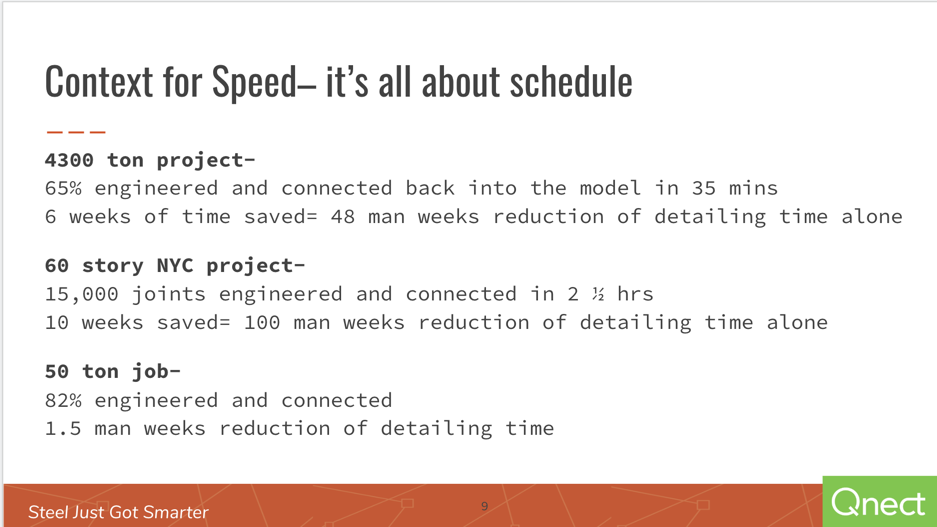
This special GC-focused webinar took place on November 20th, 2019. The webinar focuses on reducing time to construction for the general contractors....
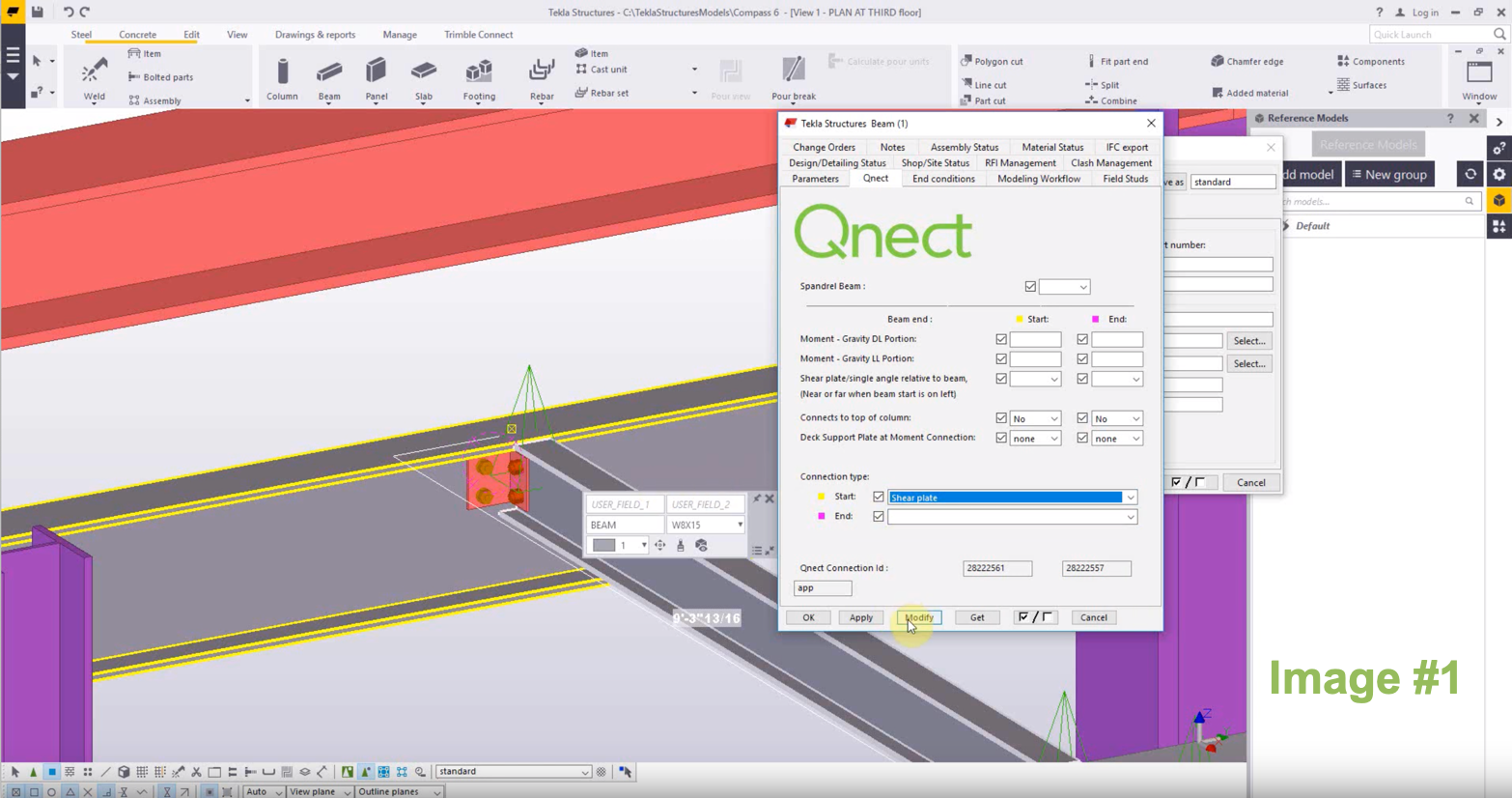
For this week's Tech Tuesday, we share how to change the connection type on the fly by combining Tekla Structures with the Qnect connection design...
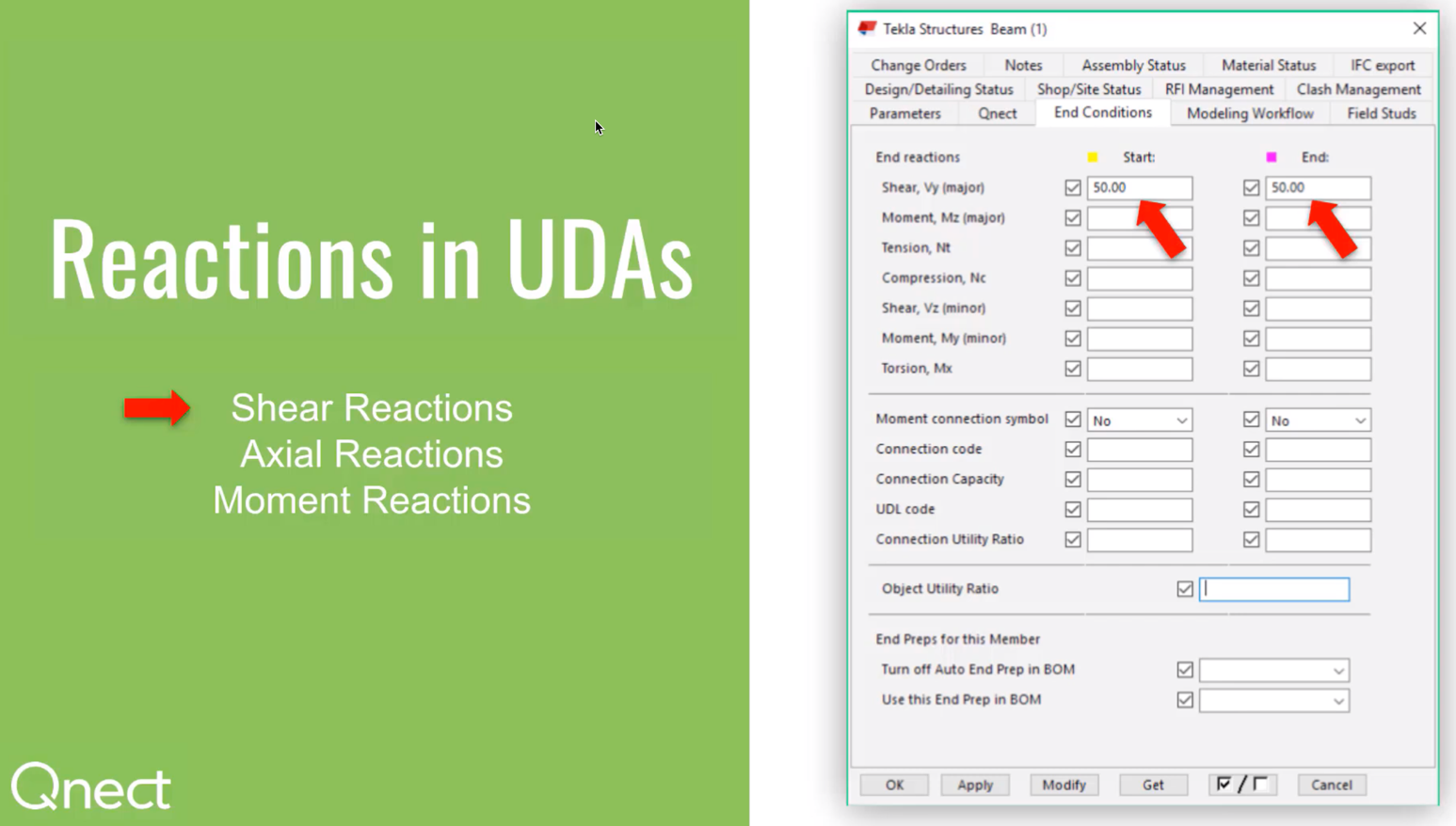
You know that proper model preparation for fabrication can prevent unnecessary headaches and frustrations. Preparing the model right the first time,...